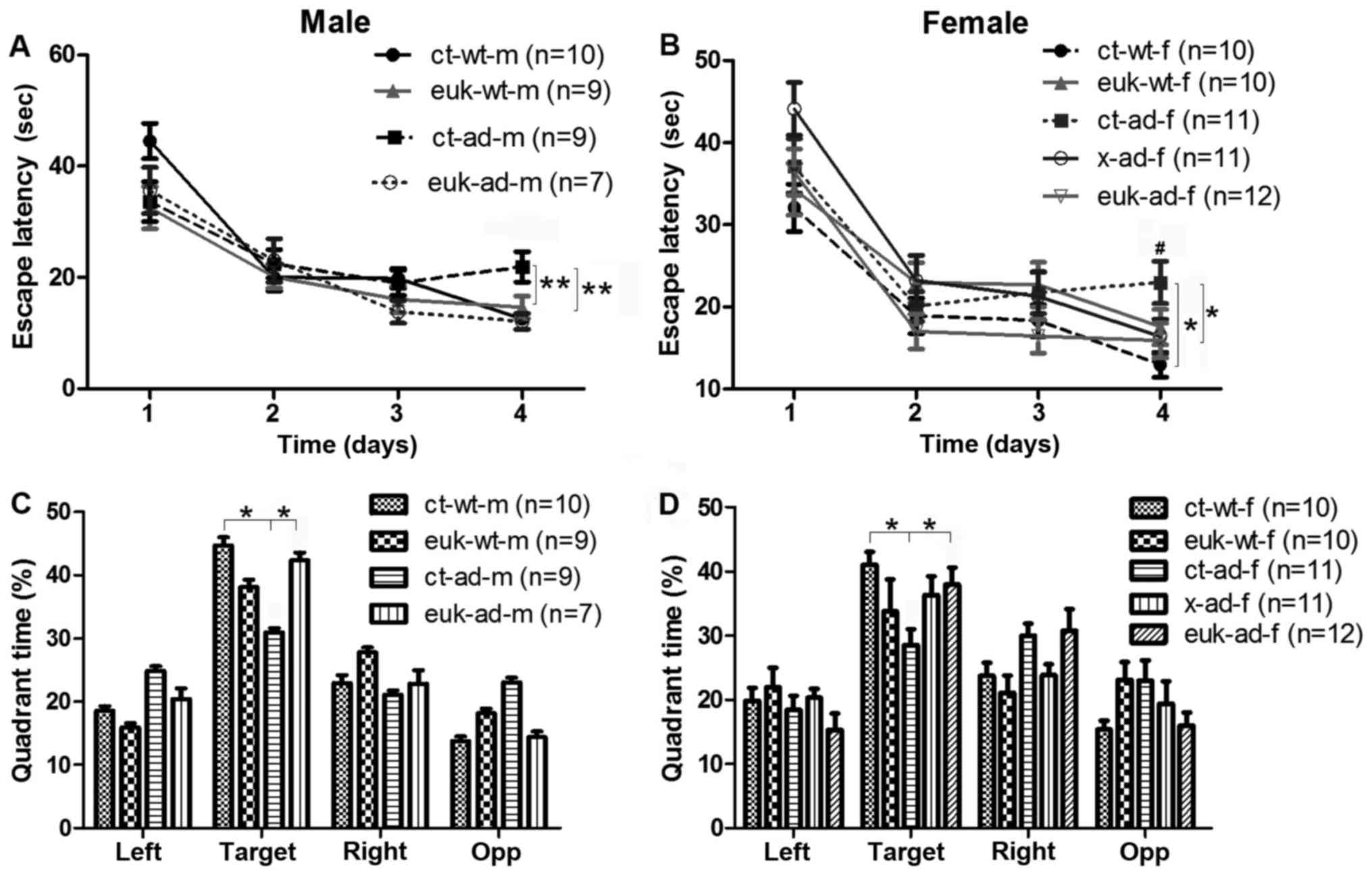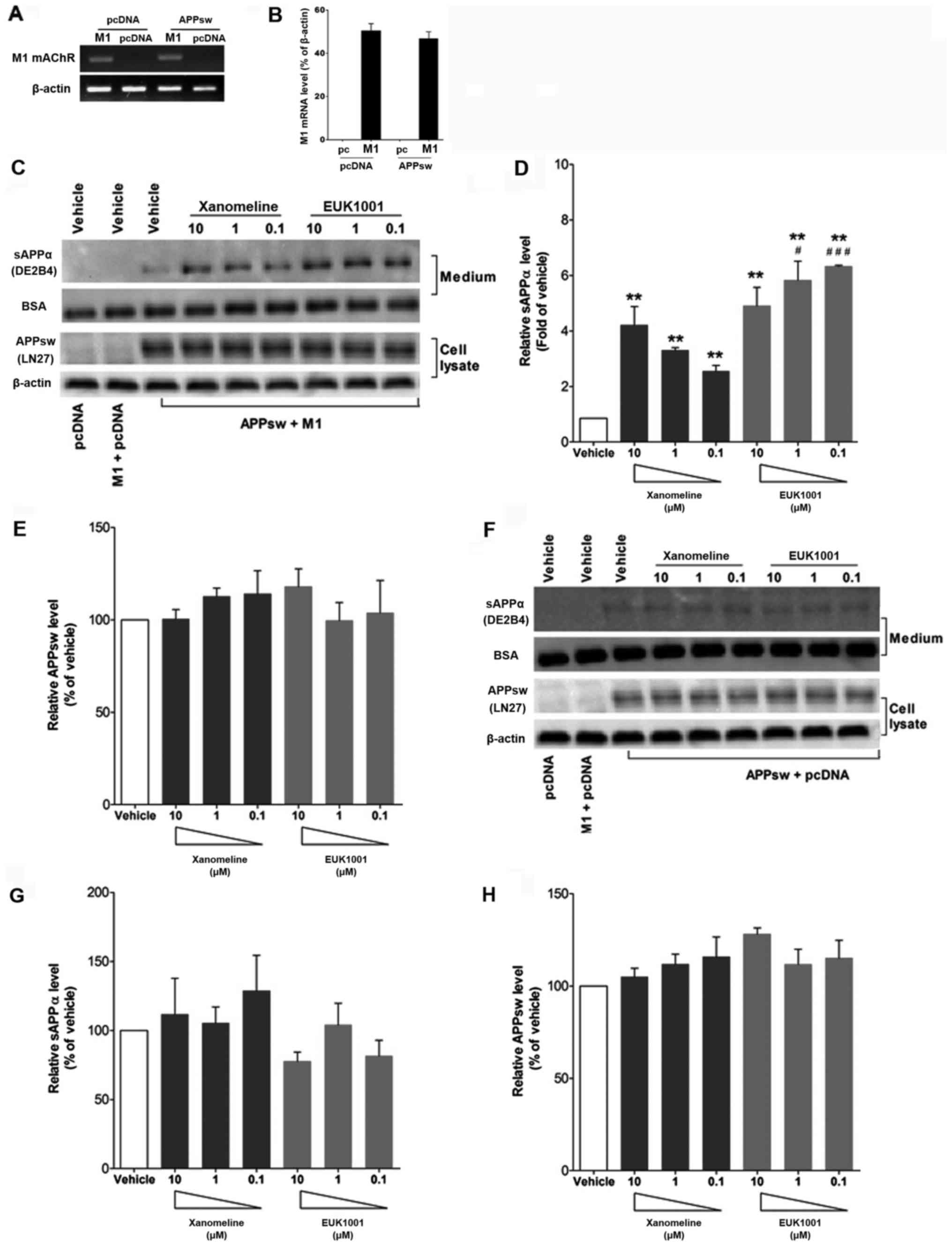|
1
|
Knapp MJ, Knopman DS, Solomon PR,
Pendlebury WW, Davis CS and Gracon SI: A 30-week randomized
controlled trial of high-dose tacrine in patients with Alzheimer's
disease. The Tacrine Study Group. JAMA. 271:985–991. 1994.
View Article : Google Scholar : PubMed/NCBI
|
|
2
|
Nordberg A, Alafuzoff I and Winblad B:
Nicotinic and muscarinic subtypes in the human brain: Changes with
aging and dementia. J Neurosci Res. 31:103–111. 1992. View Article : Google Scholar : PubMed/NCBI
|
|
3
|
Bodick NC, Offen WW, Levey AI, Cutler NR,
Gauthier SG, Satlin A, Shannon HE, Tollefson GD, Rasmussen K,
Bymaster FP, et al: Effects of xanomeline, a selective muscarinic
receptor agonist, on cognitive function and behavioral symptoms in
Alzheimer disease. Arch Neurol. 54:465–473. 1997. View Article : Google Scholar : PubMed/NCBI
|
|
4
|
Caccamo A, Oddo S, Billings LM, Green KN,
Martinez-Coria H, Fisher A and LaFerla FM: M1 receptors play a
central role in modulating AD-like pathology in transgenic mice.
Neuron. 49:671–682. 2006. View Article : Google Scholar : PubMed/NCBI
|
|
5
|
Fisher A: M1 muscarinic agonists target
major hallmarks of Alzheimer's disease-an update. Curr Alzheimer
Res. 4:577–580. 2007. View Article : Google Scholar : PubMed/NCBI
|
|
6
|
Wang D, Yang L, Su J, Niu Y, Lei X, Xiong
J, Cao X, Hu Y, Mei B and Hu JF: Attenuation of neurodegenerative
phenotypes in Alzheimer-like presenilin 1/presenilin 2 conditional
double knockout mice by EUK1001, a promising derivative of
xanomeline. Biochem Biophys Res Commun. 410:229–234. 2011.
View Article : Google Scholar : PubMed/NCBI
|
|
7
|
Cui Y, Wang D, Si W, Lv W, Niu Y, Lei X,
Hu Y and Cao X: Enhancement of memory function in aged mice by a
novel derivative of xanomeline. Cell Res. 18:1151–1153. 2008.
View Article : Google Scholar : PubMed/NCBI
|
|
8
|
Cui YH, Si W, Yin L, An SM, Jin J, Deng SN
and Cao XH: A novel derivative of xanomeline improved memory
function in aged mice. Neurosci Bull. 24:251–257. 2008. View Article : Google Scholar : PubMed/NCBI
|
|
9
|
Zhang XL, Gong Q, Zhang S, Wang L, Hu Y,
Shen H and Dong S: 3-[3-(3-florophenyl-2-propyn-1-ylthio)-1,2,
5-thiadiazol-4-yl]-1,2,5,6-tetrahydro-1-methylpyridine oxalate, a
novel xanomeline derivative, improves neural cells proliferation
and survival in adult mice. Neural Regen Res. 7:24–30.
2012.PubMed/NCBI
|
|
10
|
Beglopoulos V, Sun X, Saura CA, Lemere CA,
Kim RD and Shen J: Reduced beta-amyloid production and increased
inflammatory responses in presenilin conditional knock-out mice. J
Biol Chem. 279:46907–46914. 2004. View Article : Google Scholar : PubMed/NCBI
|
|
11
|
Feng R, Wang H, Wang J, Shrom D, Zeng X
and Tsien JZ: Forebrain degeneration and ventricle enlargement
caused by double knockout of Alzheimer's presenilin-1 and
presenilin-2. Proc Natl Acad Sci USA. 101:8162–8167. 2004;
View Article : Google Scholar : PubMed/NCBI
|
|
12
|
Saura CA, Choi SY, Beglopoulos V, Malkani
S, Zhang D, Rao BS Shankaranarayana, Chattarji S, Kelleher RJ III,
Kandel ER, Duff K, et al: Loss of presenilin function causes
impairments of memory and synaptic plasticity followed by
age-dependent neurodegeneration. Neuron. 42:23–36. 2004. View Article : Google Scholar : PubMed/NCBI
|
|
13
|
Jiang X, Zhang D, Shi J, Chen Y, Zhang P
and Mei B: Increased inflammatory response both in brain and in
periphery in presenilin 1 and presenilin 2 conditional double
knock-out mice. J Alzheimers Dis. 18:515–523. 2009. View Article : Google Scholar : PubMed/NCBI
|
|
14
|
Oddo S, Caccamo A, Shepherd JD, Murphy MP,
Golde TE, Kayed R, Metherate R, Mattson MP, Akbari Y and LaFerla
FM: Triple-transgenic model of Alzheimer's disease with plaques and
tangles: Intracellular Abeta and synaptic dysfunction. Neuron.
39:409–421. 2003. View Article : Google Scholar : PubMed/NCBI
|
|
15
|
Clinton LK, Billings LM, Green KN, Caccamo
A, Ngo J, Oddo S, McGaugh JL and LaFerla FM: Age-dependent sexual
dimorphism in cognition and stress response in the 3×Tg-AD mice.
Neurobiol Dis. 28:76–82. 2007. View Article : Google Scholar : PubMed/NCBI
|
|
16
|
Dong S, Li C, Wu P, Tsien JZ and Hu Y:
Environment enrichment rescues the neurodegenerative phenotypes in
presenilins-deficient mice. Eur J Neurosci. 26:101–112. 2007.
View Article : Google Scholar : PubMed/NCBI
|
|
17
|
Haring R, Fisher A, Marciano D, Pittel Z,
Kloog Y, Zuckerman A, Eshhar N and Heldman E: Mitogen-activated
protein kinase-dependent and protein kinase C-dependent pathways
link the m1 muscarinic receptor to beta-amyloid precursor protein
secretion. J Neurochem. 71:2094–2103. 1998. View Article : Google Scholar : PubMed/NCBI
|
|
18
|
Caccamo A, Fisher A and LaFerla FM: M1
agonists as a potential disease-modifying therapy for Alzheimer's
disease. Curr Alzheimer Res. 6:112–117. 2009. View Article : Google Scholar : PubMed/NCBI
|
|
19
|
HTL-9936 is a selective muscarinic M1
agonist designed to improve cognitive function in patients with AD
and other diseases. http://newdrugapprovals.org/2014/05/05/htl-9936-is-a-selective-muscarinic-m1-agonist-designed-to-improve-cognitive-function-in-patients-with-ad-and-other-diseases/
|













